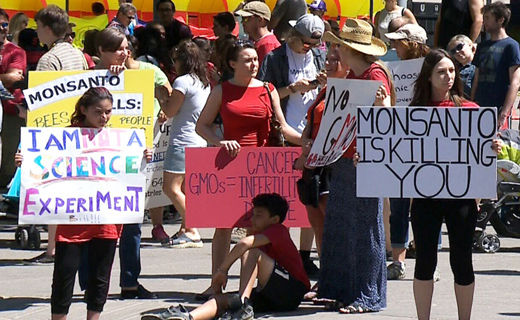
Monsanto corporation’s glyphosate, sold as “roundup,” is the world’s most widely-used herbicide. In Colombia, however, glyphosate is a weapon of war.
Pursuing their so-called drug war, the U.S. and Colombian governments, for 20 years, have used glyphosate to eradicate illegally grown coca crops.
Acting on President Juan Manuel Santos’ recommendation, Colombia’s National Drug Council on May 14 banned aerial spraying of glyphosate. The ruling has implications for beleaguered rural life in Colombia because the chemical, delivered uniquely in Colombia as an aerial spray, has far-reaching effects. And it bears on peace negotiations in Havana between FARC rebels and the Colombian government because the drug war serves as cover for counterinsurgency warfare against the FARC, at least in the minds of government opponents.
The government’s action was in response to a March 20, 2015 statement from the World Health Organization’s International Agency for Research on Cancer. The Agency claimed that glyphosate is “probably carcinogenic to humans”, that it causes “DNA and chromosomal damage in human cells.” There is “convincing evidence that [it] also can cause cancer in laboratory animals.”
Awareness of the biological workings of glyphosate is crucial to understanding why it gained worldwide use thus allowing Monsanto, one among several manufacturers, to dominate sales of the product. Glyphosate kills all growing plants within reach, with one exception. That would be any crop grown from seeds genetically altered to resist glyphosate’s noxious effects. That crop thrives; all others, especially weeds, die. Monsanto sells seeds and herbicide alike.
Together with Dow Chemical, Monsanto produced the dioxin-containing defoliant “Agent Orange” that the U.S. military applied to Vietnam. Drug war fumigations in Colombia recall that misadventure. Adverse effects have included loss of soil fertility, widespread deforestation, destruction of crops grown for food, water contamination, and a plague of human ailments. Anecdotal evidence suggests increased rates of cancer and birth defects.
Disregard of health warnings on Monsanto products may relate to the corporation’s power. Data taken from the U.S. Environmental Protection Agency suggest Monsanto knew about glyphosate’s potential for human toxicity in 1981. Animal studies then and since demonstrated low doses of glyphosate as causing “precancerous conditions” and also kidney damage that is inherited. Recent studies from Europe, Argentina, and the United States have shown glyphosate’s presence in human milk, urine, and blood. Lawyers in Los Angeles recently initiated a class action law suit against Monsanto alleging false advertising in the corporation’s claim that the herbicide “targets an enzyme only found in plants and not in humans or animals.”
In Colombia, glyphosate fumigations contributed to fear and poverty which forced rural inhabitants to abandon small landholdings and move into cities or take up residence in neighboring countries. Estimates of 6.3 million displaced Colombians rank second to figures applying to Syria, the world’s leading source of displaced persons. Some 80 percent of displaced Colombians live in poverty, 35.5 percent in extreme poverty; Colombia’s overall rural poverty rate is 65 percent. Departing families have left behind 17.5 million acres to be taken over for large scale agricultural operations, mining projects and cattle ranching.
Controlling 41 percent of seed production in the world, Monsanto ranks first in that category. It produces 90 percent of genetically modified seeds and ranks 5th in pesticide production. Presently Monsanto is trying to buy Swiss – based Syngenta Corporation, first and third in the world for pesticide and seed sales, respectively. The combined operation would generate $45 billion in annual income and control 54 percent and 33 percent, respectively, of world seed and pesticide sales. Colombian authorities have licensed Monsanto to import and sell genetically modified corn and soy seed for human use and for animal feeds.
Popular mobilizations against Monsanto, ongoing for years, have mounted recently, particularly in India, Hungary, Germany, and Argentina. In Colombia, politically left opposition groups, FARC peace negotiators among them, are backing the government’s decision to end glyphosate fumigations. They are demanding governmental support for farmers enabling them to produce and market food crops and no longer be dependent on growing coca. They denounce aerial sprayings and seek planning for sustainable rural development. The government, they say, must protect national sovereignty and no longer be “ceding to pressures from the United States … and Monsanto.”
U.S. government complicity in advancing use of genetically modified seeds and in backing Monsanto Corporation extends far beyond promotion of glyphosate areal fumigations in Colombia. The Trans-Pacific Partnership, a current priority for the Obama administration, would expand sales of genetically modified seeds and agricultural chemicals in Asian nations. Critics say the pact will injure farmers there, as was the case with NAFTA and Mexican farmers and with the U.S. – Colombia free trade agreement and Colombian farmers.
Presidential candidate Hillary Clinton labors under the burden of having voiced support for multinational corporations involved with agriculture, notably Monsanto. In 2014, Monsanto donated half a million dollars to the Clinton Family Foundation while spending more than $3 million on congressional lobbying of both Republican and Democratic legislators.
Photo: Protest against Monsanto. | ctv.ca

MOST POPULAR TODAY

High Court essentially bans demonstrations, freedom of assembly in Deep South

Zionist organizations leading campaign to stop ceasefire resolutions in D.C. area

UN warns that Israel is still blocking humanitarian aid to Gaza

U.S. imperialism’s ‘ironclad’ support for Israel increases fascist danger at home







Comments